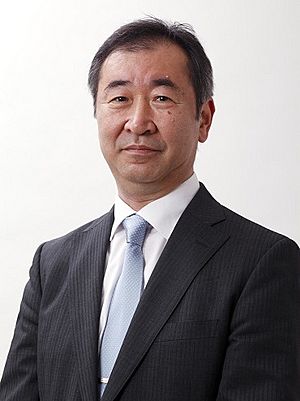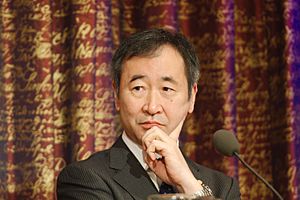Takaaki Kajita facts for kids
Quick facts for kids
Takaaki Kajita
|
|
|---|---|
| 梶田 隆章 | |

Kajita in 2017
|
|
| Born | 9 March 1959 Higashimatsuyama, Saitama, Japan
|
| Education | Saitama Prefectural Kawagoe High School |
| Alma mater | Saitama University (BS) University of Tokyo (MS, PhD) |
| Spouse(s) | Michiko |
| Awards | Asahi Prize (1988) Bruno Rossi Prize (1989) Nishina Memorial Prize (1999) Panofsky Prize (2002) Japan Academy Prize (2012) Nobel Prize in Physics (2015) Breakthrough Prize in Fundamental Physics (2016) |
| Scientific career | |
| Institutions | Kavli Institute for the Physics and Mathematics of the Universe, University of Tokyo |
| Doctoral advisor | Masatoshi Koshiba |
| Other academic advisors | Yoji Totsuka |
Takaaki Kajita (梶田 隆章, Kajita Takaaki, Japanese pronunciation: [kadʑita takaːki]; born 9 March 1959) is a Japanese physicist famous for his work studying tiny particles called neutrinos. He conducted his experiments at a special lab in Japan called the Kamioka Observatory.
His amazing discoveries about neutrinos earned him the Nobel Prize in Physics in 2015. He shared the prize with Canadian physicist Arthur B. McDonald. Since 2020, Kajita has also served as the president of the Science Council of Japan.
Contents
Early Life and Schooling
Takaaki Kajita was born in 1959 in a city called Higashimatsuyama in Japan. As a student, he loved subjects that made him think, like physics, biology, and history. He preferred understanding ideas over just memorizing facts.
After high school, he went to Saitama University to study physics, finishing in 1981. He then continued his studies at the University of Tokyo, where he earned his doctorate (the highest degree you can get at a university) in 1986. He chose to study neutrinos because he thought they "seemed like they might be interesting."
A Career Studying the Universe
Since 1988, Kajita has worked at the University of Tokyo's Institute for Cosmic Radiation Research. He became a professor there in 1999 and later the director of its Center for Cosmic Neutrinos.
Solving the Neutrino Puzzle
Kajita's most famous work happened at a huge underground detector called Super-Kamiokande. Neutrinos are mysterious particles that are created when cosmic rays from space smash into Earth's atmosphere. For a long time, scientists had a big puzzle. Their theories predicted a certain number of neutrinos coming from the Sun, but their experiments only detected about a third of them. This was called the Solar neutrino problem.
In 1998, Kajita and his team made a breakthrough discovery. They found that as neutrinos traveled through space, they could change from one "flavor" (or type) to another. This is called neutrino oscillation. This discovery was very important for two reasons:
- It proved that neutrinos must have mass. Before this, the main theory of physics, called the Standard Model, said neutrinos were massless.
- It solved the solar neutrino problem. The missing neutrinos weren't gone; they had just changed into a flavor the detectors couldn't see.
This incredible work showed that the Standard Model of physics needed to be updated.
Winning the Nobel Prize
For discovering that neutrinos can change flavors and have mass, Kajita shared the 2015 Nobel Prize in Physics. After the announcement, he joked, "I want to thank the neutrinos, of course. And since neutrinos are created by cosmic rays, I want to thank them, too."
One of the first people he called was his former teacher and fellow Nobel Prize winner, Masatoshi Koshiba.
Today, Kajita is leading another exciting project at the Kamioka Observatory. He is working on the KAGRA detector, which is designed to spot gravitational waves—tiny ripples in space and time.
Awards and Recognition
Throughout his career, Takaaki Kajita has received many awards for his important discoveries. Here are some of the most famous ones:
- Asahi Prize (1987 and 1998)
- Bruno Rossi Prize (1989)
- Panofsky Prize (2002)
- Japan Academy Prize (2012)
- Nobel Prize in Physics (2015)
- Breakthrough Prize in Fundamental Physics (2016)
In 2015, he was also awarded the Order of Culture, one of Japan's highest honors for contributions to science and the arts.
See also
 In Spanish: Takaaki Kajita para niños
In Spanish: Takaaki Kajita para niños
- List of Japanese Nobel laureates
- List of Nobel laureates affiliated with the University of Tokyo
- Masatoshi Koshiba
- Yoji Totsuka


